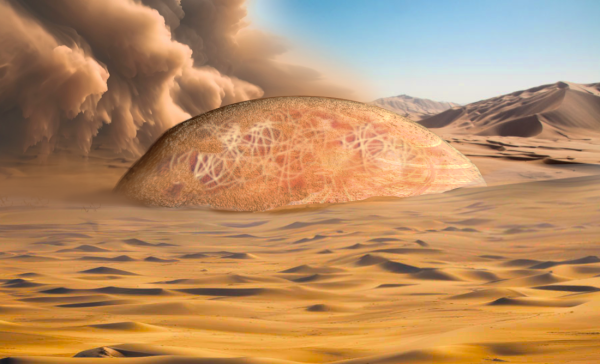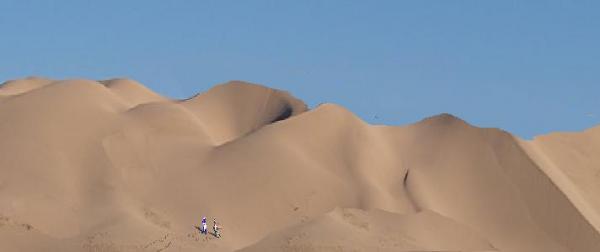BY LETTER
Sand (world)
Galactography > Sephirotic Empires > Caretaker Gods
Galactography > Regions of Space > Middle Regions/Hinter-regions
Galactography > Systems and Worlds > Systems & Worlds S - T
Galactography > Regions of Space > Middle Regions/Hinter-regions
Galactography > Systems and Worlds > Systems & Worlds S - T
 Image from Steve Bowers | |
| During sand-storms various settlements are covered by artificial domes of patterned utility sand, during which time the inhabitants interact with sandy emulations of their deceased ancestors | |
Sand - Data Panel | |
| System: | Sand |
|---|---|
| Star: | Neo Rah |
| Stellar Type: | G8 |
| Location | Gemini, 1,120ly from Sol |
| Main Planet: | Sand |
| Planet Type: | terraformed Xeric Gaian, originally AreanXeric |
| AI | AI Star System Overseer: Gentle AI Planet Overseer: The Lord of Sands Affiliation: Caretaker Gods |
Sand is a terraformed world somewhat larger than Mars (Sol System). Gravity is about 7.6 m/s and the climate is mainly arid. The early history of sand is fuzzy as little is left of the original settlements or settlers.
Barely 18% of the world's surface is covered in water and it is close enough to its home star to create a rather prevalent desert climate in most areas. There are oasis and various tropical regions spread across the planet Sand as well. Great sand dune fields that cover nearly 65% of the planets surface separate these oases.
Two moons orbit the world. One is a small 160km diameter rocky world know as Shimmer due to its somewhat shiny appearance. The other is a metal rich larger world roughly 450km in diameter known as Gentler.
Some time in the early history of the settlement of Sand, a self-evolving form of silicon-based nanites were created. These eventually destroyed much of the planet's infrastructure.
The residents were a group of desert tweaks. These tweaks managed to survive the disaster but were reduced to a primitive technological level. The nanites evolved into a utility-sand based intelligence, which is the main reason for the sand dunes that cover the planet. The silicon nanites reproduced slowly at first avoiding the wetter organic regions around the oasis. It was this tendency that spared the ecology of Sand from total destruction.
A Caretaker god archai passed through the system at some time during this period. It interacted with the silicon nanite intelligence and tweaked it into becoming transapient itself. Once this was done Gentle moved to live on the moon.
The local tweaks christened the Caretaker archai Gentle, because of the calming effect that the archai had on the sand-based entity. The local name for the moon now became Gentler.
Gentle set up defence systems to protect the world of Sand from outside influences and has left the planet pretty much alone ever since.
The transapient Utility Sand entity that evolved from the silicon nanites became known as The Lord of Sands and eventually developed a symbiotic relationship with the Sand Tweaks.
Currently the Sand Tweaks exist as a primitive, but diverse culture clustered around the oasis of Sand. The high priests of the Lord of Sands control travel across the planet and are worshipped by the local populace as an extension of their god.
The high priests of the Sand Tweak cultures spend time alone among the great dunes in communion with the Lord of the Sands. Those who reach favor with the Lord of Sands gain powers over the dunes allowing them to influence trade, war, and other aspects of the world.
An interesting cultural aspect of the relationship between Sand Tweaks and the Lord of Sands is involved in the disposal of the dead. When someone dies on Sand a small sandstorm develops that envelopes and carries away the body. The memories of the dead are preserved and become part of the Lord of Sands. The Sand priest can bring forth avatars of the dead at need.
The world of Sand is periodically swept by natural and partially artificial sandstorms. These are seen as large-scale manifestations of the Lord of Sands and occasionally envelop the entire planet for days or even weeks at a time. The Lord of Sands protects the settlements of the Sand Tweaks.
During these sandstorms a hollow dome of utility sand covers each settlement. The roof and walls of these domes move in mysterious patterns during the storm, and during these times the ancestors of that settlement are recreated in utility sand. They appear to walk the streets interacting with their descendants, friends, and families. It is a time of great celebration among the Sand tweaks when one of the Great Sand storms sweeps the planet for these reasons.
 Image from Steve Bowers |
Related Articles
Appears in Topics
Development Notes
Text by James Ramsey
Initially published on 17 March 2003.
Initially published on 17 March 2003.






